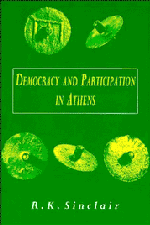Book contents
- Frontmatter
- Contents
- Preface
- Maps
- 1 The Athenian polis and the evolution of democracy
- 2 The privileges and the opportunities of the citizen
- 3 The responsibilities of the citizen
- 4 The sovereignty of the Demos, officials and the Council
- 5 Citizens and participation
- 6 The hazards of leadership
- 7 The rewards of leadership
- 8 The critics of Athenian democracy
- Appendix 1 The population of Athens
- Appendix 2 ‘Working days’
- Appendix 3 Notes on three constitutional matters
- Bibliography
- Index
5 - Citizens and participation
Published online by Cambridge University Press: 01 June 2011
- Frontmatter
- Contents
- Preface
- Maps
- 1 The Athenian polis and the evolution of democracy
- 2 The privileges and the opportunities of the citizen
- 3 The responsibilities of the citizen
- 4 The sovereignty of the Demos, officials and the Council
- 5 Citizens and participation
- 6 The hazards of leadership
- 7 The rewards of leadership
- 8 The critics of Athenian democracy
- Appendix 1 The population of Athens
- Appendix 2 ‘Working days’
- Appendix 3 Notes on three constitutional matters
- Bibliography
- Index
Summary
The Council of 500: active participation or manipulation?
Democracy (dēmokratia) in Athens rested on the power or sovereignty (kratos) of the Demos. This sovereignty was exercised, as we have seen, in the making of policy decisions and administrative decisions in the Ekklesia which all citizens were entitled to attend, while at least in the fourth century matters of an ongoing or universal kind were discussed in the Ekklesia but finally determined by the process of nomothesia. In the dispensing of justice, decisions rested with citizen juries which, by their size and the use of the Lot in their selection, might be expected to represent a cross-section of the sovereign people. Similarly, size, use of the Lot and recruitment from all the demes provided grounds for applying the description ‘the polis in miniature’ to the Boule – the council which played a vital role not only in the decision-making process, but also in the supervision of the implementation of the assembly's decisions. Finally, apart from the few officials who were elected (by the Demos), the use of the Lot, rotation and limited tenure provided the citizens with enhanced opportunities for serving as officials and for engaging in the ruling of the polis.
The very structure and the leading features of Athenian institutions therefore worked strongly in favour of involving large numbers of citizens; but did the citizens avail themselves of their opportunities?
- Type
- Chapter
- Information
- Democracy and Participation in Athens , pp. 106 - 135Publisher: Cambridge University PressPrint publication year: 1988

